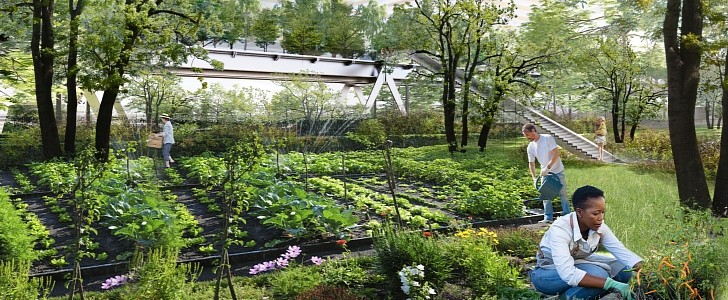More and more architectural and design projects are centered around sustainable concepts, integrating the natural surroundings in a harmonious way, and enabling a stronger connection with nature. The future Parco Romana, in Italy, is a great example of how to turn an old area dedicated to conventional transportation into a contemporary space that enhances urban mobility.
A large railway yard that has left its imprint on the Porta Romana district in Milan, Italy, for over a century, will soon become a modern example of sustainability and eco-friendly urban mobility. An international team of experts in several domains, including CRA (Carlo Ratti Associati and Arup), has won the competition for this complex redevelopment project.
A Great Park will be developed over the railway that bisects the site in order to reconnect the entire neighborhood. An elevated greenway, called the Suspended Forest, will seamlessly blend hundreds of trees with the railway infrastructure. Gardens and various green spaces will be designed alongside the tracks, moving the focus from an industrial perspective to one that’s based on health and sustainability.
The open spaces will be framed by modern buildings, including a residential district at the western edge, which will be initially used to house the athletes participating in the Milan 2026 Winter Olympics. After the event is over, the area will be turned into a permanent residential district, including a generous public piazza. The piazza will integrate various spaces for outdoors exercise, food trucks, cultural events, all developed around historic sheds for train repairs.
According to the Carlo Ratti studio, the project will also enhance mobility for pedestrians and cyclists, by creating various corridors that will be connected to the major public spaces. This is part of a broader concept in urban mobility, where everything that’s required for daily necessities should be available within a short walk, as an indirect way of cutting CO2 emissions resulted from transportation.
The future Parco Romana will also integrate self-sufficiency as much as possible, focusing on renewable energy, circular economy, and climate adaptation.
A Great Park will be developed over the railway that bisects the site in order to reconnect the entire neighborhood. An elevated greenway, called the Suspended Forest, will seamlessly blend hundreds of trees with the railway infrastructure. Gardens and various green spaces will be designed alongside the tracks, moving the focus from an industrial perspective to one that’s based on health and sustainability.
The open spaces will be framed by modern buildings, including a residential district at the western edge, which will be initially used to house the athletes participating in the Milan 2026 Winter Olympics. After the event is over, the area will be turned into a permanent residential district, including a generous public piazza. The piazza will integrate various spaces for outdoors exercise, food trucks, cultural events, all developed around historic sheds for train repairs.
According to the Carlo Ratti studio, the project will also enhance mobility for pedestrians and cyclists, by creating various corridors that will be connected to the major public spaces. This is part of a broader concept in urban mobility, where everything that’s required for daily necessities should be available within a short walk, as an indirect way of cutting CO2 emissions resulted from transportation.
The future Parco Romana will also integrate self-sufficiency as much as possible, focusing on renewable energy, circular economy, and climate adaptation.








